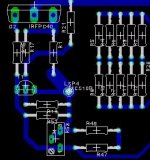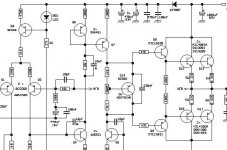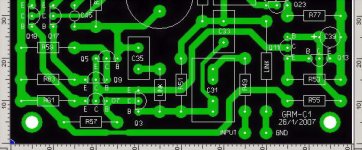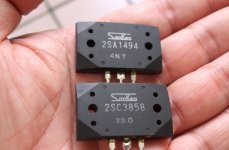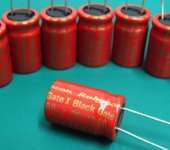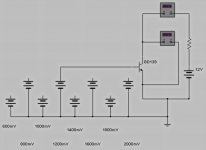Folks are sending me mails with suggestions to me to assemble
some Class A amplifiers they have appreciated.
Sorry folks...no more Class A.
I will re start to build Class A when US started to talk only French...when start to rain from the ground to the skies... when people decide to burn their flags and change the world..when Ford Motor Company start to sell only electrical cars... when rich countries decide not to polute anymore...when you will not detect anymore corruption in Brazil and when girls decide to let us in peace having our own freedom and not to convince us to get married with them and when Amazon river start to dry.
regards,
Carlos
some Class A amplifiers they have appreciated.
Sorry folks...no more Class A.
I will re start to build Class A when US started to talk only French...when start to rain from the ground to the skies... when people decide to burn their flags and change the world..when Ford Motor Company start to sell only electrical cars... when rich countries decide not to polute anymore...when you will not detect anymore corruption in Brazil and when girls decide to let us in peace having our own freedom and not to convince us to get married with them and when Amazon river start to dry.
regards,
Carlos
other peoples designs are somewhat difficult to judge.
What about your own - do you tried one of the DX amplifiers biased into A mode?
regards
What about your own - do you tried one of the DX amplifiers biased into A mode?
regards
No Yurgen..... interesting.... i have never imagine that.
Maybe i will...not a promisse.... re-calculate to increase currents into the Dx Standard and listen to see what happens..for sure will be a little bit mufled too.
But you have made me feel curiosity..... despite i am sure will have this loss into the high end.
Well... Dx Standard is not the best amplifier into the high end.... i think it will turn worse biased into class A.
Will see that into the future..and maybe..... now a days i have a lot of other amplifiers to build... Techno from Bora, Cyrus and some other ones too.
Also will build Nelson Pass F5, modified to Class AB, and using transistors.
Do not know if i will really do.... i am quite sure about the result.
This is not so big problem..there are other kind of amplifiers to me to use and to enjoy.
terrible is to have a name alike mine.... Carlos.... Car... loss... when i could have a name alike Ihurgüen (Yurgen spelled into my language).
Not guaranteed to test... will loose my time....but there is a curiosity... the 0.0001 percent chance to result different...maybe if i increase the AB bias will work nice... a super biased AB amplifier... the same effect as an underbiased Class A amplifier.
regards,
Carlos
Maybe i will...not a promisse.... re-calculate to increase currents into the Dx Standard and listen to see what happens..for sure will be a little bit mufled too.
But you have made me feel curiosity..... despite i am sure will have this loss into the high end.
Well... Dx Standard is not the best amplifier into the high end.... i think it will turn worse biased into class A.
Will see that into the future..and maybe..... now a days i have a lot of other amplifiers to build... Techno from Bora, Cyrus and some other ones too.
Also will build Nelson Pass F5, modified to Class AB, and using transistors.
Do not know if i will really do.... i am quite sure about the result.
This is not so big problem..there are other kind of amplifiers to me to use and to enjoy.
terrible is to have a name alike mine.... Carlos.... Car... loss... when i could have a name alike Ihurgüen (Yurgen spelled into my language).
Not guaranteed to test... will loose my time....but there is a curiosity... the 0.0001 percent chance to result different...maybe if i increase the AB bias will work nice... a super biased AB amplifier... the same effect as an underbiased Class A amplifier.
regards,
Carlos
Attachments
I have also the Cyrus one
The one has sent me boards and transistors are waiting for me to assemble more than one year long...it is time to make it.
I have assembled point to point years ago and i found sound very good.
Not it is time to make it more pretty.
Well... sound will not turn better because of that....but the friend will be more happy because of that.
Would be interesting if someone wants to try Dx Standard into Class A... i would help the guy to make it...... would be good..as i am busy with those others.
regards,
Carlos
The one has sent me boards and transistors are waiting for me to assemble more than one year long...it is time to make it.
I have assembled point to point years ago and i found sound very good.
Not it is time to make it more pretty.
Well... sound will not turn better because of that....but the friend will be more happy because of that.
Would be interesting if someone wants to try Dx Standard into Class A... i would help the guy to make it...... would be good..as i am busy with those others.
regards,
Carlos
Attachments
They have sold some... there are others
Will send you the link but will not post it.
regards,
Carlos
Will send you the link but will not post it.
regards,
Carlos
I was thinking, if you find class A to sound muffled and prefer the sound of class AB, why use class A in the previous stages? You should make the whole amp class AB.
Because the quiescent point Nelson... the operation point
You see... earlier stages are class A, but a very low current ones.... VBE is very low, from 500 to 600 milivolts are very often found voltages.
Your automobile operational rpm goes from 1000 rpm to 7000 rpm (normal standard motors)..... so.... if you run it into 4000 rpm you gonna have room to acelerate and decelerate...... it may work cool this way.
But instead of that, decide to operate it into 6000 rpm all time long...you gonna have room to acelerate and will force engine using routations were your engine does not lubricate very well...the machine may work overheated into high temperature environments.... of course you will have a lot of room to descend, to reduce routations per minute.
So.... Class AB and Class A are decisions alike the engine rotations per minute you may use while travelling from home to work and back home once again.
You can decide lower point..... using 2500 rpm... having a lot of room to increase and lower room to decrease....you can choice 4000 rpm and you can choose another point of operation.
I do not know if this is confused.... well... also this some subjective way to understand how things goes.... maybe i am not rigth about... it is possible that Class A is biased exaclty into the mid range... and this is the best logical idea...but i prefer sound results when the current is lower...maybe because perfectly linear, or because not perfect linearity.
Into the theory, nothing can be better than biasing into class A... keeping you distant from the crossover points will be great... if you manage to operate without reaching the crossover point will be special.... good would be never reaching cut or saturation.... good when you can swing inside some free range... having room to operate without reaching extreme conditions.
regards,
Carlos
You see... earlier stages are class A, but a very low current ones.... VBE is very low, from 500 to 600 milivolts are very often found voltages.
Your automobile operational rpm goes from 1000 rpm to 7000 rpm (normal standard motors)..... so.... if you run it into 4000 rpm you gonna have room to acelerate and decelerate...... it may work cool this way.
But instead of that, decide to operate it into 6000 rpm all time long...you gonna have room to acelerate and will force engine using routations were your engine does not lubricate very well...the machine may work overheated into high temperature environments.... of course you will have a lot of room to descend, to reduce routations per minute.
So.... Class AB and Class A are decisions alike the engine rotations per minute you may use while travelling from home to work and back home once again.
You can decide lower point..... using 2500 rpm... having a lot of room to increase and lower room to decrease....you can choice 4000 rpm and you can choose another point of operation.
I do not know if this is confused.... well... also this some subjective way to understand how things goes.... maybe i am not rigth about... it is possible that Class A is biased exaclty into the mid range... and this is the best logical idea...but i prefer sound results when the current is lower...maybe because perfectly linear, or because not perfect linearity.
Into the theory, nothing can be better than biasing into class A... keeping you distant from the crossover points will be great... if you manage to operate without reaching the crossover point will be special.... good would be never reaching cut or saturation.... good when you can swing inside some free range... having room to operate without reaching extreme conditions.
regards,
Carlos
Some ideas, i suggest you test them if does not already known
It seems to me the problem happens, and this is perceived by my ears, subjective, personal evaluation..... because many others do not agree.... happens because the advanced biasing point.
When you send audio to transistors, despite AC, the signal has electrical energy... positive and negative potencial... this drives the transistors as you know.... the base voltage may travel from 550 milivolts to 750 milivolts as consequence of the signal injected... and you see this is centered into 650 milivolts.
650 milivolts plus 100 milivolts results into 750 milivolts (maximum)
650 milivolts (ideal voltage into the base informed into books) less 100 milivolts results 550 milivolts.
So.... this way, you will have nor cut (transistor going off) and no saturation too… will be operating more to the cut side (off side) then to the saturating extreme.
But if you center your operation into 830 milivolts, 900 milivolts or even more...then you will not be very well centered...will operate more near the saturation…. When operating close the saturation…. transistor saturated sounds, of course, saturated…this is awfull, means hard distortion…. While into the other side, the audio will bias the transistor if cutted during some small moments…will enter class B (can happens) for some time, will produce a crossover click and will return to normal operation..less harmfull…my opinion of course..others think this is a crime!...well… I love Strawberries, others appreciate Mango
Despite saturation is distant….around 2 volts into some TO220 transistors used as drivers, and despite they start to conduct around 600 milivolts from base to emitter, you
have the good range and the bad range to use… it is up to you… do this test offered, use potentiometers to adjust base voltage and check what happens real life… this one presents 500 milivolts from colector to emitter when saturated, and the current during
saturation is 500 miliamperes… saturating voltage from the base to the emitter is 2 volts .. minimum voltage to drive the unit is 600 milivolts into the base…then you will understand what I mean… if not already understood.
regards,
Carlos
It seems to me the problem happens, and this is perceived by my ears, subjective, personal evaluation..... because many others do not agree.... happens because the advanced biasing point.
When you send audio to transistors, despite AC, the signal has electrical energy... positive and negative potencial... this drives the transistors as you know.... the base voltage may travel from 550 milivolts to 750 milivolts as consequence of the signal injected... and you see this is centered into 650 milivolts.
650 milivolts plus 100 milivolts results into 750 milivolts (maximum)
650 milivolts (ideal voltage into the base informed into books) less 100 milivolts results 550 milivolts.
So.... this way, you will have nor cut (transistor going off) and no saturation too… will be operating more to the cut side (off side) then to the saturating extreme.
But if you center your operation into 830 milivolts, 900 milivolts or even more...then you will not be very well centered...will operate more near the saturation…. When operating close the saturation…. transistor saturated sounds, of course, saturated…this is awfull, means hard distortion…. While into the other side, the audio will bias the transistor if cutted during some small moments…will enter class B (can happens) for some time, will produce a crossover click and will return to normal operation..less harmfull…my opinion of course..others think this is a crime!...well… I love Strawberries, others appreciate Mango
Despite saturation is distant….around 2 volts into some TO220 transistors used as drivers, and despite they start to conduct around 600 milivolts from base to emitter, you
have the good range and the bad range to use… it is up to you… do this test offered, use potentiometers to adjust base voltage and check what happens real life… this one presents 500 milivolts from colector to emitter when saturated, and the current during
saturation is 500 miliamperes… saturating voltage from the base to the emitter is 2 volts .. minimum voltage to drive the unit is 600 milivolts into the base…then you will understand what I mean… if not already understood.
regards,
Carlos
Attachments
Hey
Decided to bump this thread because I did not want to destroy Carlos other trhead where he biases his DX into Class A.
...but Carlos: I feel the same about Class A!
Class A sound could be described as very clean and with strong bass weight, but my recent experiments with Class AB amplifiers I find it to have more 3D stage, depth and dynamics.
So maybe you would say that I 'convinced myself' into this perception of sound exactly because I also think about the environment... but HEY - despite all measurements and things, aren't hifi in reality more about "how we think it sounds"?
It is undeniable that Class A power amplifiers measure better...but again: You should listen instead of measuring, so that argument doesn't even comply.
I think a lot of people just choose the 'easy' class A amplifiers, because everywhere you can read that these have the best sound. I say easy because 1) you don't have to worry about thermal runaway = less trimming, and 2) you can easily satisfy the perception of 'bigger is better' and go beserk in massive heatsinks and huge transformers telling yourself:" Hey - this is class A... I need the big stuff!"
...You know what guys - I challenge you to "step up the game", do some better engineering, trim that thermal compensation, calculate the 'right' size of heatsinks and transformers. If you do it right you can get just as good sound - or maybe even better!
And then you would not have wasted all that aluminum, or you could get 2x 200W instead of 2x 40W with the same heatsink (more headrooom= better dynamics).
And then you even don't have to get suspicous, judgemental evil-eye looks from your non-audio friends, when you tell them that your huge 700W roomheater lump of metal is only producing 2Watts, but the sound is oooooh so good!
....catch my drift?
Decided to bump this thread because I did not want to destroy Carlos other trhead where he biases his DX into Class A.
...but Carlos: I feel the same about Class A!
Class A sound could be described as very clean and with strong bass weight, but my recent experiments with Class AB amplifiers I find it to have more 3D stage, depth and dynamics.
So maybe you would say that I 'convinced myself' into this perception of sound exactly because I also think about the environment... but HEY - despite all measurements and things, aren't hifi in reality more about "how we think it sounds"?
It is undeniable that Class A power amplifiers measure better...but again: You should listen instead of measuring, so that argument doesn't even comply.
I think a lot of people just choose the 'easy' class A amplifiers, because everywhere you can read that these have the best sound. I say easy because 1) you don't have to worry about thermal runaway = less trimming, and 2) you can easily satisfy the perception of 'bigger is better' and go beserk in massive heatsinks and huge transformers telling yourself:" Hey - this is class A... I need the big stuff!"
...You know what guys - I challenge you to "step up the game", do some better engineering, trim that thermal compensation, calculate the 'right' size of heatsinks and transformers. If you do it right you can get just as good sound - or maybe even better!
And then you would not have wasted all that aluminum, or you could get 2x 200W instead of 2x 40W with the same heatsink (more headrooom= better dynamics).
And then you even don't have to get suspicous, judgemental evil-eye looks from your non-audio friends, when you tell them that your huge 700W roomheater lump of metal is only producing 2Watts, but the sound is oooooh so good!
....catch my drift?
Nice Nrik...no troubles at all.
I can agree with you in some parts...well...each one of us are different..this is good...world would be very boring if all folks behaves and thinks the same way.
regards,
Carlos
I can agree with you in some parts...well...each one of us are different..this is good...world would be very boring if all folks behaves and thinks the same way.
regards,
Carlos
....catch my drift?
Maybe the added distortion (up to 10% open loop) when switching between Class A and Class B sounds good in your current setup?
Maybe the added distortion (up to 10% open loop) when switching between Class A and Class B sounds good in your current setup?
...which is why you dont wanna use open loops.
The majority of all amps (also high-end) are still class AB.
I can agree with you in some parts...well...each one of us are different..this is good...world would be very boring if all folks behaves and thinks the same way.
regards,
Carlos

Carlos - I give you full credit and say that I also think Class A can sound muffled, and that I also think it is a waste of energy. Did you change your mind at some point? ( if yes - then I missed it)
According to me there are only two reasons why class A can sound "muffled", you like the effect of crossover distortion or there are something wrong with the design of the amplifier.
According to me there are only two reasons why class A can sound "muffled", you like the effect of crossover distortion or there are something wrong with the design of the amplifier.
People love the sound of distortion
😀😀😀😀😀
- Status
- Not open for further replies.
- Home
- Amplifiers
- Solid State
- What to do with class A amplifiers to avoid some mufled treble

